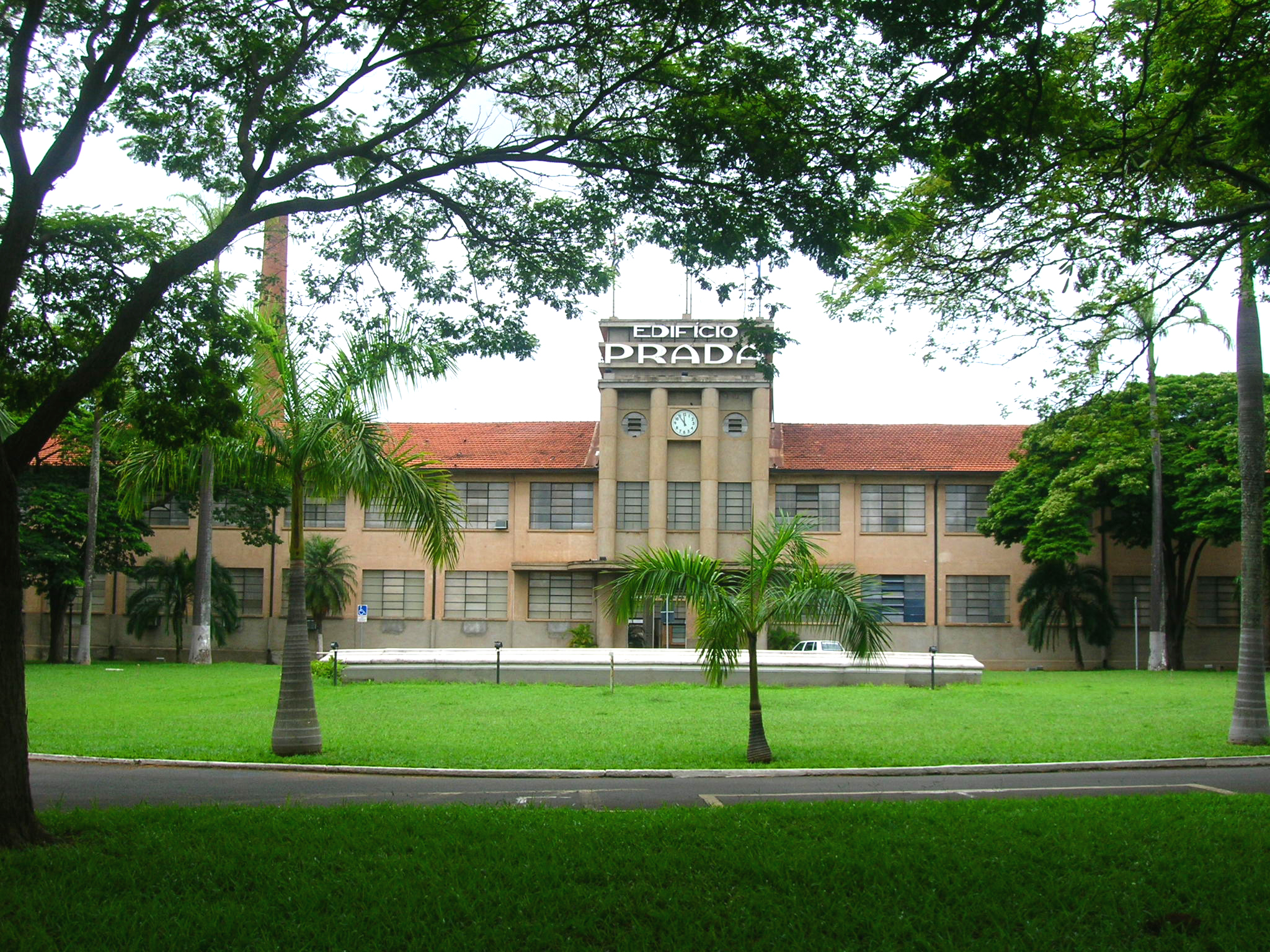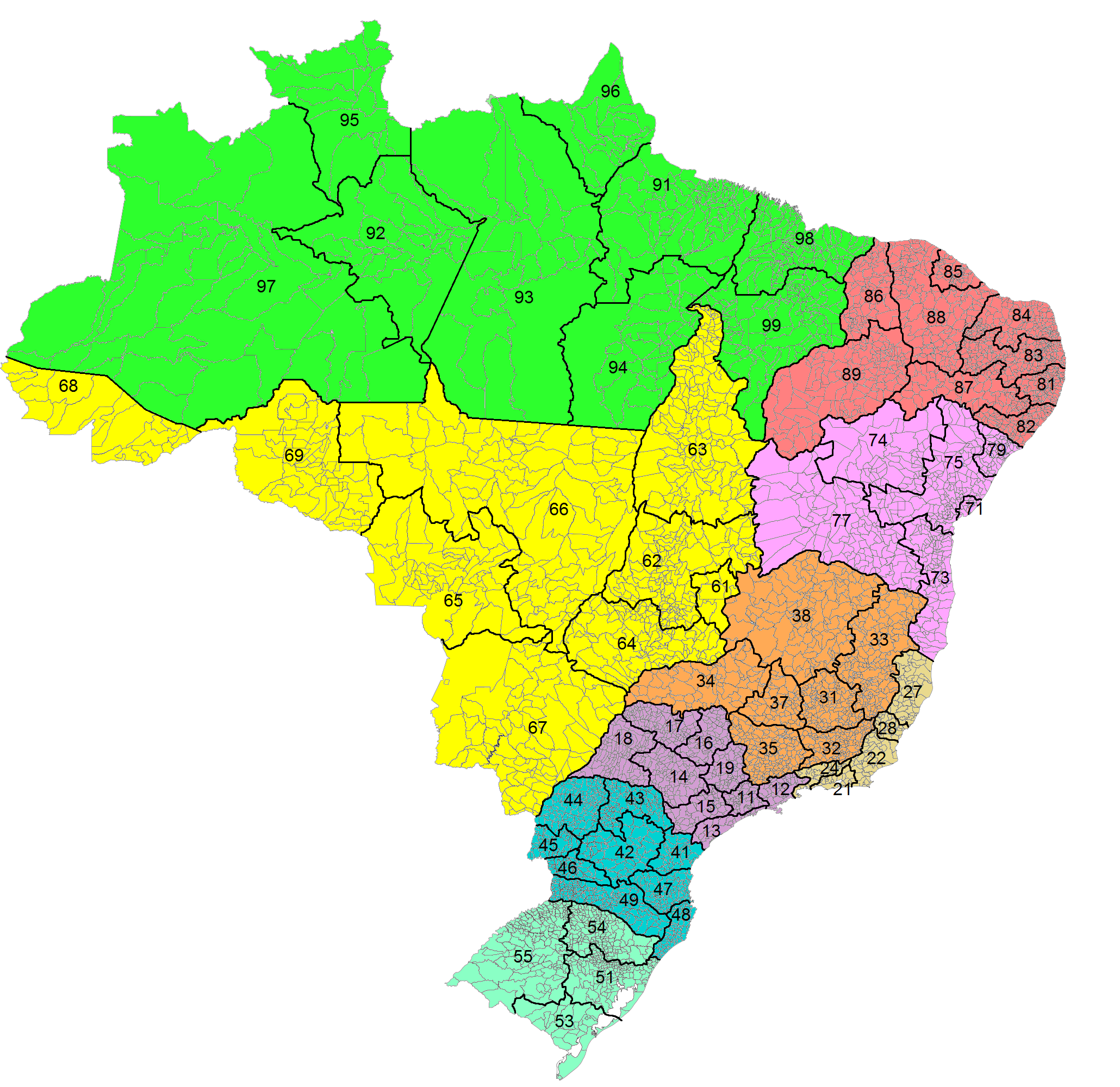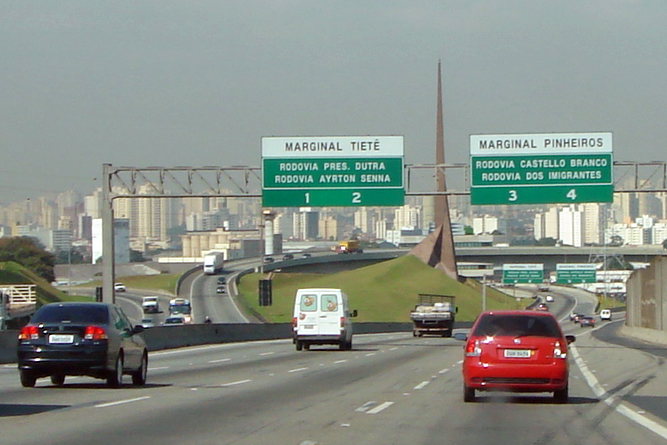|
Limeira
Limeira is a city in the eastern part of the Brazilian state of São Paulo. The population is 308,482 (2020 est.) in an area of 581 km2. The elevation is 588 m. It is 154 km from São Paulo, the state capital, and 1011 km from Brasilia, Brazil's capital. The city can be easily reached from São Paulo by two highways: Rodovia Anhanguera and Rodovia dos Bandeirantes. Once an important and strategical pole of the coffee culture, Limeira was also known as the "Brazilian orange capital" due to the great citrus production that occurred in the past, although now the main crop cultivated in the city is the sugar cane. Afterwards, it became recognized by its new plated jewelry and semi-jewelry industry which attract customers from all over the world, giving the city the title of "Brazil's plated jewellery capital". There are more than 450 companies that are responsible for half of Brazil's exports in this sector. There is a famous farm located in Limeira, Fazenda Ibi ... [...More Info...] [...Related Items...] OR: [Wikipedia] [Google] [Baidu] |
Rodovia Anhanguera
The Rodovia Anhanguera (official designation SP-330) (In English: Anhanguera Highway) is a highway in the state of São Paulo, Brazil. It is one of the country's busiest transportation corridors. A 2005 survey conducted amongst Brazilian truck drivers rated it as the best transportation axis in the country. The Anhanguera Highway connects the city of São Paulo with the northeastern part of the state of São Paulo going through industrial cities and one of the most productive agricultural areas. It is one of the most important highways in Brazil and one of the busiest, with the highest traffic segment between São Paulo and Campinas, the first to be built. It is duplicated, containing sections with additional tracks and marginal clues. They have heavy traffic, especially of trucks. It is considered, together with the Bandeirantes Highway and the Washington Luis Highway, the country's largest financial corridor, since it interconnects some of the state's metropolitan regions such ... [...More Info...] [...Related Items...] OR: [Wikipedia] [Google] [Baidu] |
Nicolau Pereira De Campos Vergueiro
Nicolau Pereira de Campos Vergueiro, better known as Senator Vergueiro ( pt, Senador Vergueiro) (20 December 1778 – 17 September 1859), was a Portuguese-born Brazilian coffee farmer and politician. He was a pioneer in the implementation of free workforce in Brazil by bringing the first European immigrants to work in the Ibicaba farm, which he owned. The contract was prepared by Vergueiro himself, establishing ownership of the production and other measures, mostly of an exploitive nature. Faced with this, the immigrants working in Vergueiro's main property, the Ibicaba farm, revolted under the guidance of Thomas Davatz, a Swiss immigrant and religious leader, who instigated the immigrant workers to grow their ambition to become small or medium-sized landowners, as they imagined they would be when they had left Europe. Biography Vergueiro was born on 20 December 1778 in Vale da Porca, Portugal, to Luiz Bernardo Pereira Vergueiro and Clara Maria Borges Campos. He graduated with ... [...More Info...] [...Related Items...] OR: [Wikipedia] [Google] [Baidu] |
Fazenda Ibicaba
The Ibicaba Farm (in Portuguese: Fazenda Ibicaba) is one of the most known farms of Brazil. Established in 1817 by senator Nicolau Vergueiro, it was widely known as one of the most macabre symbols of slavery in the province of São Paulo. Afterwards, it became a pioneer in the replacement of the African enslaved by European immigrants' labour and in the use of the steam engine, cart and plough. The Ibicaba has also served as a military headquarters during the Paraguayan War, receiving the Emperor Dom Pedro II, princess Isabel and her husband, the count Gaston of Eu. In the 19th century, it was the stage of a revolt of the European immigrants that worked there, led by Thomas Davatz, a Swiss immigrant. The revolt exposed to the European authorities the conditions in which their former citizens lived in Brazil. By 1882, Italian immigration to Brazil grew significantly, encouraging the aftermost massive immigration of Italians to the whole state of São Paulo São Paulo (, ; P ... [...More Info...] [...Related Items...] OR: [Wikipedia] [Google] [Baidu] |
List Of Dialling Codes In Brazil
Country Code: +55 International Call Prefix: 00 then Carrier Code Trunk Prefix: 0 then Carrier Code This article contains a list of area codes in Brazil for telephone dialing. The area codes are distributed geographically, citing the main cities in each area. Local phone numbers in Brazil observe an eight-digit pattern (''nnnn-nnnn'') for landlines and nine digits (''nnnnn-nnnn'') for mobile phones. Mobile numbers share the same geographic area codes as landlines, but the first digit differentiates them. Landline numbers start with digits ''2'' through ''5''. Initial digits ''6'' through ''9'' are reserved for mobile numbers, but as of 2017 all mobile numbers in Brazil start with the digit ''9''. (There is an exception for some iDEN mobile lines operated by Nextel, which are eight digits long and start with ''7'' and disestablished in 2018.) Area codes have two digits, and are often notated between parentheses: ''(aa) nnnn-nnnn''. For long-distance calls within Brazil, a zero ... [...More Info...] [...Related Items...] OR: [Wikipedia] [Google] [Baidu] |
Rodovia Dos Bandeirantes
The Rodovia Bandeirantes (official designation SP-348) is a highway in the state of São Paulo, Brazil. Once the traffic capacity of the Anhangüera Highway was exceeded in the 1960s, the state government decided to build another highway, with a much higher capacity and modern design, directly connecting São Paulo City to Jundiaí, Campinas and merging into the Anhangüera just after Campinas. Among the first six-lane highways in Brazil, it opened to traffic in 1978. It has always been a toll road, and since 1998, the highway is managed by a state contract with a private company, AutoBan. Subsequently, in 2001 it was extended to Santa Bárbara d'Oeste merging with the Washington Luis Highway, to Rio Claro, São Carlos, Araraquara and São José do Rio Preto. In 2006, it was widened to 4 lanes each way between São Paulo and Jundiaí. It is today the major thoroughfare between several mighty industrial cities around São Paulo and Campinas, and the Viracopos Airport, the sec ... [...More Info...] [...Related Items...] OR: [Wikipedia] [Google] [Baidu] |
Municipalities Of Brazil
The municipalities of Brazil ( pt, municípios do Brasil) are administrative divisions of the states of Brazil, Brazilian states. Brazil currently has 5,570 municipalities, which, given the 2019 population estimate of 210,147,125, makes an average municipality population of 37,728 inhabitants. The average state in Brazil has 214 municipalities. Roraima is the least subdivided state, with 15 municipalities, while Minas Gerais is the most subdivided state, with 853. The Federal District (Brazil), Federal District cannot be divided into Municipality, municipalities, which is why its territory is composed of several Administrative regions of the Federal District (Brazil), administrative regions. These regions are directly managed by the government of the Federal District, which exercises constitutional and legal powers that are equivalent to those of the Federated state, states, as well as those of the Municipality, municipalities, thus simultaneously assuming all the obligations a ... [...More Info...] [...Related Items...] OR: [Wikipedia] [Google] [Baidu] |
African-Brazilian
Afro-Brazilians ( pt, afro-brasileiros; ) are Brazilians who have predominantly African ancestry (see " preto"). Most members of another group of people, multiracial Brazilians or ''pardos'', may also have a range of degree of African ancestry. Depending on the circumstances (situation, locality, etc.), the ones whose African features are more evident are always or frequently seen by others as "africans" - consequently identifying themselves as such, while the ones for whom this evidence is lesser may not be seen as such as regularly. It is important to note that the term pardo, such as preto, is rarely used outside the census spectrum. Brazilian society has a range of words, including negro itself, to describe multiracial people. Preto and pardo are among five ethnic categories used by the Brazilian Institute of Geography and Statistics, along with '' branco'' ("white"), '' amarelo'' ("yellow", East Asian), and '' indígena'' (Native American). In 2010, 7.6% of the Brazilian po ... [...More Info...] [...Related Items...] OR: [Wikipedia] [Google] [Baidu] |
Slavery
Slavery and enslavement are both the state and the condition of being a slave—someone forbidden to quit one's service for an enslaver, and who is treated by the enslaver as property. Slavery typically involves slaves being made to perform some form of work while also having their location or residence dictated by the enslaver. Many historical cases of enslavement occurred as a result of breaking the law, becoming indebted, or suffering a military defeat; other forms of slavery were instituted along demographic lines such as race. Slaves may be kept in bondage for life or for a fixed period of time, after which they would be granted freedom. Although slavery is usually involuntary and involves coercion, there are also cases where people voluntarily enter into slavery to pay a debt or earn money due to poverty. In the course of human history, slavery was a typical feature of civilization, and was legal in most societies, but it is now outlawed in most countries of the w ... [...More Info...] [...Related Items...] OR: [Wikipedia] [Google] [Baidu] |
Portugal
Portugal, officially the Portuguese Republic ( pt, República Portuguesa, links=yes ), is a country whose mainland is located on the Iberian Peninsula of Southwestern Europe, and whose territory also includes the Atlantic archipelagos of the Azores and Madeira. It features the westernmost point in continental Europe, and its Iberian portion is bordered to the west and south by the Atlantic Ocean and to the north and east by Spain, the sole country to have a land border with Portugal. Its two archipelagos form two autonomous regions with their own regional governments. Lisbon is the capital and largest city by population. Portugal is the oldest continuously existing nation state on the Iberian Peninsula and one of the oldest in Europe, its territory having been continuously settled, invaded and fought over since prehistoric times. It was inhabited by pre-Celtic and Celtic peoples who had contact with Phoenicians and Ancient Greek traders, it was ruled by the Ro ... [...More Info...] [...Related Items...] OR: [Wikipedia] [Google] [Baidu] |
Europe
Europe is a large peninsula conventionally considered a continent in its own right because of its great physical size and the weight of its history and traditions. Europe is also considered a Continent#Subcontinents, subcontinent of Eurasia and it is located entirely in the Northern Hemisphere and mostly in the Eastern Hemisphere. Comprising the westernmost peninsulas of Eurasia, it shares the continental landmass of Afro-Eurasia with both Africa and Asia. It is bordered by the Arctic Ocean to the north, the Atlantic Ocean to the west, the Mediterranean Sea to the south and Asia to the east. Europe is commonly considered to be Boundaries between the continents of Earth#Asia and Europe, separated from Asia by the drainage divide, watershed of the Ural Mountains, the Ural (river), Ural River, the Caspian Sea, the Greater Caucasus, the Black Sea and the waterways of the Turkish Straits. "Europe" (pp. 68–69); "Asia" (pp. 90–91): "A commonly accepted division between Asia and E ... [...More Info...] [...Related Items...] OR: [Wikipedia] [Google] [Baidu] |
Immigrant
Immigration is the international movement of people to a destination country of which they are not natives or where they do not possess citizenship in order to settle as permanent residents or naturalized citizens. Commuters, tourists, and other short-term stays in a destination country do not fall under the definition of immigration or migration; seasonal labour immigration is sometimes included, however. As for economic effects, research suggests that migration is beneficial both to the receiving and sending countries. Research, with few exceptions, finds that immigration on average has positive economic effects on the native population, but is mixed as to whether low-skilled immigration adversely affects low-skilled natives. Studies show that the elimination of barriers to migration would have profound effects on world GDP, with estimates of gains ranging between 67 and 147 percent for the scenarios in which 37 to 53 percent of the developing countries' workers migrate ... [...More Info...] [...Related Items...] OR: [Wikipedia] [Google] [Baidu] |
Jewelry
Jewellery ( UK) or jewelry (U.S.) consists of decorative items worn for personal adornment, such as brooches, rings, necklaces, earrings, pendants, bracelets, and cufflinks. Jewellery may be attached to the body or the clothes. From a western perspective, the term is restricted to durable ornaments, excluding flowers for example. For many centuries metal such as gold often combined with gemstones, has been the normal material for jewellery, but other materials such as glass, shells and other plant materials may be used. Jewellery is one of the oldest types of archaeological artefact – with 100,000-year-old beads made from ''Nassarius'' shells thought to be the oldest known jewellery.Study reveals 'oldest jewellery' , '' |





